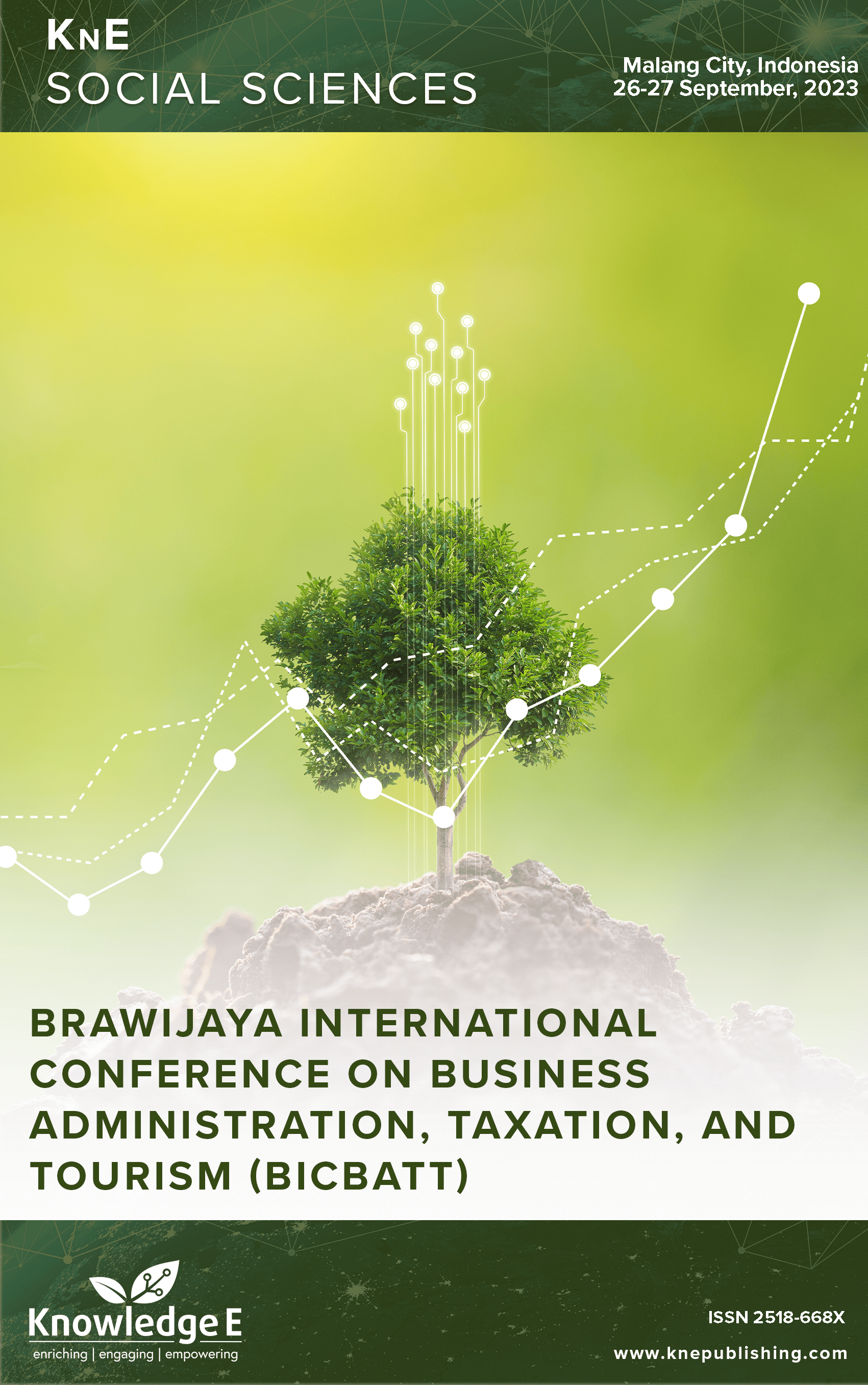The Mediation Role of Perceived Risk, Trust, and Perceived Security Toward Intention to Use in the Model of Fintech Application Adoption: An Extension of TAM
DOI:
https://doi.org/10.18502/kss.v9i11.15804Abstract
The advancement of information technology fosters business transaction activities that necessitate its continued development in terms of both usefulness and intentions, including the use of information technology-based financial services, commonly referred to as financial technology (fintech). This article aims to examine conceptual studies on the desire to utilize financial technology as it is mediated by perceived security, trust, and risk. This conceptual article aims to discuss the perceptions of users/potential users of fintech applications, discuss previous research on fintech, and propose a conceptual framework regarding intention to use fintech applications. The research results are expected to be taken into consideration for users/prospective users who adopt fintech applications by mediating perceived risk, trust, and perceived security.
Keywords: fintech, intention to use, perceived risk, perceived security, trust
References
Verma S, Shome S, Hassan MK. FinTech in small and medium enterprises ( SMEs ): A review and future research agenda. Eur Manag J. 2023. DOI: https://doi.org/10.1016/j.emj.2023.07.003
Wulan VR. Financial Technology (fintech) a New Transaction in Future. JEECS J Electr Eng Comput Sci. 2017;2:177–82. DOI: https://doi.org/10.54732/jeecs.v2i1.160
Martinelli I. Menilik Financial Technology dalam Bidang Perbankan. J Sos Hum Komun. 2021;2:32–43. DOI: https://doi.org/10.53695/js.v2i1.353
Rahadiyan I. Perkembangan Financial Technology Di Indonesia Dan Tantangan Pengaturan Yang Dihadapi. Artif Intell Law. 2020;31–48.
Davis FD. Perceived usefulness, perceived ease of use, and user acceptance of information technology. MIS Q Manag Inf Syst. 1989;13:319–39. DOI: https://doi.org/10.2307/249008
Almaiah MA, Al-Rahmi A, Alturise F, Hassan L, Lutfi A, Alrawad M, et al. Investigating the effect of perceived security, perceived trust, and information quality on mobile payment usage through near-field communication (NFC) in Saudi Arabia. Electron Switz. 2022;11:1–22. DOI: https://doi.org/10.3390/electronics11233926
Jangir K, Sharma V, Taneja S, Rupeika-Apoga R. The moderating effect of perceived risk on users’ continuance intention for FinTech services. J Risk Financ Manag. 2023;16. DOI: https://doi.org/10.3390/jrfm16010021
Wu J, Liu L, Huang L. Consumer acceptance of mobile payment across time Antecedents and moderating role of diffusion stages. Ind Manag Data Syst. 2017;117:1761–76. DOI: https://doi.org/10.1108/IMDS-08-2016-0312
Tsiakis T, Sthephanides G. The concept of security and trust in electronic payments. Comput Secur. 2005;24:10–5. DOI: https://doi.org/10.1016/j.cose.2004.11.001
Stewart H, Jürjens J. Data security and consumer trust in FinTech innovation in Germany. Inf Comput Secur. 2018;26:109–28. DOI: https://doi.org/10.1108/ICS-06-2017-0039
Lee W-J. Understanding consumer acceptance of fintech service: An extension of the TAM Model to understand Bitcoin. J Bus Manag. 2018;20:34–7.
Sudono FS, Adiwijaya M, Siagian H. The influence of perceived security and perceived enjoyment on intention to use with attitude towards use as intervening variable on mobile payment customer in Surabaya. Petra Int J Bus Stud. 2020;3:37– 46. DOI: https://doi.org/10.9744/ijbs.3.1.37-46
Natakusumah K, Maulina E, Muftiadi A, Purnomo M. Integrating religiosity into a technology acceptance model for the adoption of mobile payment technology. Int J Data Netw Sci. 2023;7:305–12. DOI: https://doi.org/10.5267/j.ijdns.2022.10.003
Marangunić N, Granić A. Technology acceptance model: a literature review from 1986 to 2013. Univers Access Inf Soc. 2015;14:81–95. DOI: https://doi.org/10.1007/s10209-014-0348-1
Gefen. Trust and TAM in online shopping: An Integrated Model By: MIS Q Manag Inf Syst. 2003;1:51–90. DOI: https://doi.org/10.2307/30036519
Udo GJ, Bagchi KK, Kirs PJ. An assessment of customers’ e-service quality perception, satisfaction and intention. Int J Inf Manag. 2010;30:481–92. DOI: https://doi.org/10.1016/j.ijinfomgt.2010.03.005
McKnight DH, Chervany NL. What trust means in e-commerce customer relationships: An interdisciplinary conceptual typology. Int J Electron Commer. 2001;6:35–59. DOI: https://doi.org/10.1080/10864415.2001.11044235
Yousafzai SY, Pallister JG, Foxall GR. Strategies for building and communicating trust in electronic banking: A field experiment. Psychol Mark. 2005;22:181–201. DOI: https://doi.org/10.1002/mar.20054
Kim C, Tao W, Shin N, Kim KS. An empirical study of customers’ perceptions of security and trust in e-payment systems. Electron Commer Res Appl. 2010;9:84–95. DOI: https://doi.org/10.1016/j.elerap.2009.04.014
Chawla D, Joshi H. Consumer attitude and intention to adopt mobile wallet in India – An empirical study. Int J Bank Mark. 2019;37:1590–618. DOI: https://doi.org/10.1108/IJBM-09-2018-0256
Yousafzai SY, Pallister JG, Foxall GR. A proposed model of e-trust for electronic banking. Technovation. 2003;23:847–60. DOI: https://doi.org/10.1016/S0166-4972(03)00130-5
Putri GA, Widagdo AK, Setiawan D. Analysis of financial technology acceptance of peer to peer lending (P2P lending) using extended technology acceptance model (TAM). J Open Innov Technol Mark Complex. 2023;9:100027. DOI: https://doi.org/10.1016/j.joitmc.2023.100027
Murdiyanto T, Mahatama Y. Pengembangan Alat Peraga Matematika Untuk Meningkatkan Minat Dan Motivasi Belajar Matematika Siswa Sekolah Dasar. Sarwahita. 2014;11:38. DOI: https://doi.org/10.21009/sarwahita.111.07
Najib M, Fahma F. Investigating the adoption of digital payment system through an extended technology acceptance model: An insight from the Indonesian small and medium enterprises. Int J Adv Sci Eng Inf Technol. 2020;10:1702–8. DOI: https://doi.org/10.18517/ijaseit.10.4.11616
Al Nawayseh MK. Fintech in COVID-19 and beyond: What factors are affecting customers’ choice of fintech applications? J Open Innov Technol Mark Complex. 2020;6:1–15. DOI: https://doi.org/10.3390/joitmc6040153
Atikah I. Consumer protection and fintech companies in Indonesia: Innovations and challenges of the financial services authority. J Huk Dan Peradil. 2020;9:132. DOI: https://doi.org/10.25216/jhp.9.1.2020.132-153
Arpaci I, Kilicer K, Bardakci S. Effects of security and privacy concerns on educational use of cloud services. Comput Hum Behav. 2015;45:93–8. DOI: https://doi.org/10.1016/j.chb.2014.11.075
Madden TJ, Ellen PS, Ajzen I. A comparison of the theory of planned behavior and the theory of reasoned action. Pers Soc Psychol Bull. 1992;18:3–9. DOI: https://doi.org/10.1177/0146167292181001
Lee MC. Factors influencing the adoption of internet banking: An integration of TAM and TPB with perceived risk and perceived benefit. Electron Commer Res Appl. 2009;8:130–41. DOI: https://doi.org/10.1016/j.elerap.2008.11.006
Kumar A, Adlakaha A, Mukherjee K. The effect of perceived security and grievance redressal on continuance intention to use M-wallets in a developing country. Int J Bank Mark. 2018;36:1170–89. DOI: https://doi.org/10.1108/IJBM-04-2017-0077
Venkatesh V, Bala H. Technology acceptance model 3 and a research agenda on interventions. Decision Sciences 2008;39:2. DOI: https://doi.org/10.1111/j.1540-5915.2008.00192.x
Venkatesh V, Davis FD. A theoretical extension of the technology acceptance model: Four Longitudinal Field Studies. Management Science 2000;46:186-204. DOI: https://doi.org/10.1287/mnsc.46.2.186.11926

